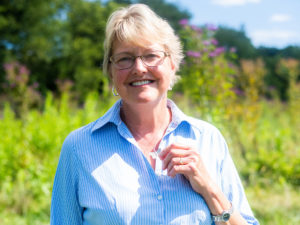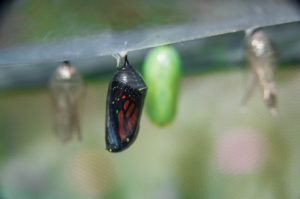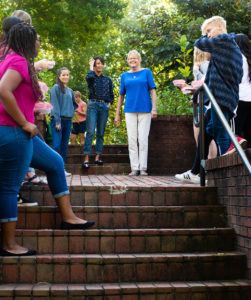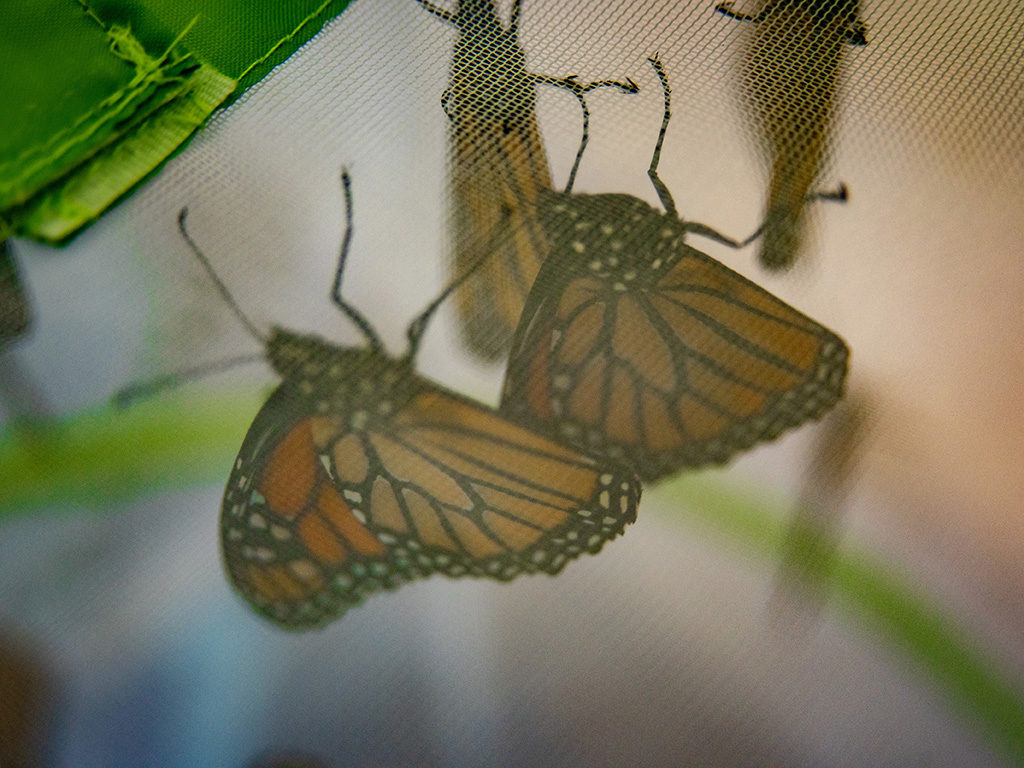Laurie Roelofs’ shared passion for butterflies and Berea students
Imagine walking along the trails of Alumni fields and finding a path leading to what looks like a beautiful garden. As you approach the garden, you begin to see grassy pathways, all sorts of flowers and finally, butterflies. Butterflies of all colors fluttering above and around you. You come closer to smell one of the flowers and see the bright colors of a monarch butterfly pass by.
This place exists thanks to the efforts of Berea College First Lady Laurie Roelofs. Roelofs cares about teaching and being connected to the environment, and she has dedicated both her life and her time as first lady to promote it.
For the first five years of her working career, Roelofs was a registered nurse and the head nurse for a 52-bed surgical floor. She later became a teacher and a mom. She also has been a supportive partner of President Lyle Roelofs, whom she married 43 years ago. Their love story started on a college campus as well, when Laurie met Lyle during her first year at Calvin College in Michigan.
“Of all the various jobs I’ve had, this is so far the busiest, yet most rewarding one of all,” she said with a smile. As first lady, she is part of multiple committees on campus, including the Frost Committee which oversees the Historic Boone Tavern Hotel and Restaurant. She represents the City of Berea on the Community Operations Board for the Center for the Arts, and is active with the Progress Club and various Berea women’s clubs. Her responsibilities also include traveling with the president, visiting donors to promote the College and its mission and welcoming many, many visitors to the president’s home.

than 18 years. It all began when she was as a teacher. While teaching children about the
life cycles of monarch butterflies, the magnificent creatures captured her heart.
In addition to her duties as first lady, Roelofs loves to talk about the work she has done for the environment and, particularly, monarch butterflies.
It all began 20 years ago, when she was as a teacher. While teaching children about the life cycle of monarch butterflies, the magnificent creatures captured her heart.
“I worry about them; we aren’t careful enough with nature or the creatures out there,” Roelefs said.
With climate change and droughts, monarchs often must endure harsher weather in their over-wintering sites in Mexico. Also, logging in those forests (until it was prohibited recently) has resulted in habitat destruction. In places north of Mexico, where they spend their summers and go through several generations, spraying crops has reduced the milkweed population necessary to their life cycle.
“To improve crop yields they spray the fields, which is bad for the butterflies and the milkweed around,” Roelofs explained. “The monarchs need milkweed to lay their eggs.”
Monarchs are not the only pollinator population that is under stress, of course. Other butterfly species and bees are also affected by pesticides. For this and other reasons, the Berea College Farm follows strict organic protocols and chemicals are not used on Berea’s campus. Some butterfly species over- winter here and their chrysalises, intended by nature to be disguised as little leaves, are often thrown away as part of fall clean-up of flower gardens.

Seeing all this damage and the lack of awareness moved Roelofs to take her teachings beyond the kindergarten classroom to advocate for environmental practices that support monarch and pollinator populations. Bringing this interest with her to Berea, she has started several monarch waystations on the Berea College campus. Monarch waystations are gardens or areas that provide the milkweed necessary for the monarch life cycle, shelter needed for the chrysalises and flowering plants as a food supply for butterflies and other pollinators.
“Watching the butterflies is like seeing Berea College students,” Roelofs said. “I like seeing them grow and become what or who they are meant to be.”
Roelofs now collaborates with biology professor Dr. Ronald Rosen, who, upon seeing under the microscope a monarch egg collected by the first lady, was captivated. He added a unit to his laboratory class in which students collect eggs in one of the monarch waystations, observe the entire life cycle of the monarch and then release it once it has grown.

The first lady herself has been raising butterflies for educational purposes for more than 18 years, and in Berea she and her monarchs have visited kindergartners at Berea Community Elementary School (thanks to their Berea alum teacher, Belinda Cummins Riddle) and students from the Child Development Laboratory have visited the president’s home to help release them.
“I go and find the eggs,” Roelofs said. “I don’t order them online because I don’t like monarch farms or the idea of butterflies being shipped in little cardboard boxes. Once I’ve found the eggs, I bring them home.”
Once hatched, she feeds the caterpillar fresh milkweed and, when it is big enough, she puts it in a cage on a stalk of milkweed for it to climb up and down as it pleases, as if it were in its natural environment. Eventually, it suspends itself from a stalk or the top of a cage and turns into a chrysalis.

Once the butterflies emerge from the chrysalises, she keeps them for a day to make sure their wings are suited for flying and then releases them at the waystations.
With help from wonderful Berea staff members Rose Adams, Valerie Frost and Janet Meyer, Roelofs’ efforts also include the creation of a “secret garden,” located in the brushy area of Alumni fields, down the hill behind the president’s home. Anyone can visit to see the flowers, birds, butterflies and other insects, all enjoying the area.
She does not expect everybody to raise butterflies, but hopes rather, that everyone will become more careful about the environment.
“Keep it simple,” she explained. “I always tell people to plant nectar sources, to avoid spraying or to talk to a county commissioner about not spraying the roadsides, because milkweed can grow there.”
Roelofs believes people want to learn, just like her students always have. “I used to tell the children I taught, ‘Respect our classroom, respect each other, respect the environment,’” she said.
Roelofs said there are many ways to help the environment, and she emphasized how important it is for future generations. As a continuation of her efforts toward the preservation of nature, Roelofs plans to look into Berea being designated as a bee campus—to recognize it is a good environment for these important creatures and other pollinators and to promote environmental awareness to our many visitors.
“It scares me how we don’t seem to be taking these things seriously,” she said. “I have grand kids, and I want there to be butterflies for them.”

